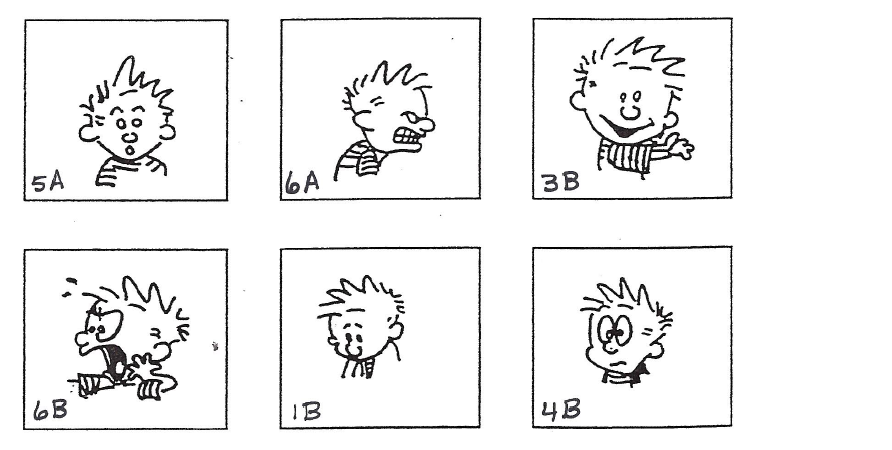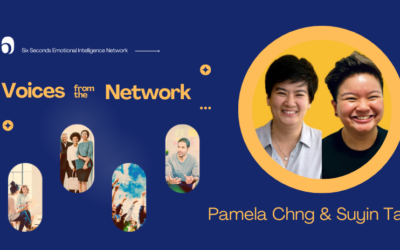Emo-Shines: What an Imaginary World with Visible Emotions Can Teach Us About Language, Labeling Emotions, and Practicing EQ
By Anabel Jensen

Just before drifting off to sleep a few nights ago, I found myself wondering what life would be like without words. It sounded absurd, but I decided to indulge the thought for a few moments.
Objects would have no discrete labels. People would all somehow have the same name, if any name at all. It would be a mightily confusing place to live, sure, but an interesting one. Tarrying a few moments in such a world reminds us of the importance of having comprehensible labels for the things we see, and the actions we want to describe.
Words As Thoughts
It goes much further than mere convenience, of course. Words make up thoughts. We can only think in the words that we know, and as each one becomes attached to objects, people, ideas or memories, we build our ability to describe – and simultaneously, to understand- the world. It’s a very complex, multi-year task, but as soon as the basics fall into place, we find that our emotional warp and weft creates a new tapestry. Even more subtly, and in ways which constantly change, these emotions represent our inner lives, an ongoing masterpiece unavailable to anyone else. From this inner self come the habits which will define us, but often these habits, and the emotions behind them, prove too subtle for identification.
So, I was supposed to be falling asleep, but instead, I explored a related question: What if every subtle turn of our emotions were immediately obvious to us? And – just for fun – I pondered: What would happen if emotions were also visible to everyone else?
Emo-Shines: Visible Feelings

Imagine a parallel universe in which, instead of forming into words, emotions were to cause our bodies to shine a certain color. In some ways, this would be more communicative than language, because it would be visible to all, permanently, and require only interpretation. We’d emit a huge range of colors over the course of a day, from the sunny yellows of happiness to the dulled browns of evening exhaustion, with all the gleeful game-playing greens (or raging red arguments) in between. Apart from providing a spectacle, Emo-Shines like these would make our inner lives legible to anyone.
As things are, our emotional lives are mostly a lonely province, known only to the brain which generated them, but they change quickly, tumbling along in parallel to the goings-on outside. We are triggered or appeased by events, overjoyed or overwhelmed by the things we hear, or tweaked by subtle chemical manipulation.
To an observer, a fully representative Emo-Shine would flicker and change more quickly than we can perceive. Like a record played at too high a speed, perhaps, it forms an indistinct blur from which we can grasp only some repeating themes.
The Importance of Labeling our Emotions
That’s because it’s challenging to stand in the presence of each emotion, examining and identifying and labeling it, seeing its uniqueness and distinguishing it from the others. We don’t have the mental bandwidth, or the time;
But in reality, for many of us, the gap between ourselves and our emotional lives comes not from lack of effort, but from quirks in our use of language.
Labeling: A Skill and a Form of Therapy

Look around and name the colors you see. Go on, try it. There’s a point, I promise.
Now, how many of you said ‘yellow’, compared to ‘mustard’, or ‘butterscotch’? Who chose to subdivide the simple, primary ‘red’ into the more descriptive ‘scarlet’, or ‘crimson’, or ‘rose’?
This might just reveal that we answered quickly, or that we might need to pick up a few new words for describing colors. [Here is a great place to find some.]
Both individually and collectively, we need a generous vocabulary for emotions. Importantly, research is finding a connection between language deficits and problems regulating emotions. People who write regularly in a journal find they’re more able to grapple with their feelings because each one has gone through the process of verbal expression. Laid-off workers who wrote journals were found to have better physical and mental health than those who didn’t, and to find work more easily.
Maybe it’s obvious, but if we can label something accurately, we can begin to address it properly. We can also see that an emotion is an unwanted guest, a neurochemical impostor, simply by giving it a name.
Finding the Right Words
Being able to articulate the emotions we’re feeling helps to bring their effects under control. [For Marvel fans, I’d say, “Hulk angry!!” is a dramatic exception to this rule.] This requires a subtlety of differentiation, and also new abilities to describe and label our emotional reactions. This is the way to gradually differentiate ‘being nervous’, from ‘being confused’ and ‘feeling vulnerable’, even though they’re all different hues of the same basic feeling: anxiety.

To take another example, you probably know someone you’d describe as ‘always angry’. For me, it’s a work colleague, and watching his emotions shift and develop through a day, it’s obvious that they’re more complex than just ‘anger’. Our own feelings can be hard to differentiate, and those of someone else doubly so, but I’ve noticed some subtleties: he shifted from depressive dismay (at the state of the world) to habituated defensiveness (during a testy staff meeting), and then afterward, became grumpy (because no one backed him up), and disgusted (with those who he feels betrayed him).
By skipping the opportunity to slow down and label these distinct feelings, my colleague isn’t learning to articulate the nuances of his emotional life. If he could, he might notice his dismay, label it accurately, and thereby become able to set it aside. Apart from the effects of his emotions on others (tears in the staff room), he’s making himself sad by wallowing in an ill-defined but negative emotion because it creates neurochemical results he finds reassuring or pleasing. This is how we enter destructive cycles – by not recognizing the ingredients of such a cycle, we dive in, hoping it’ll scratch the right itch.
He’s also failing to recognize the origins of his feelings. Noisy construction work near his home has left him depressed and disillusioned with the area where he lives. He’s defensive in meetings because he misinterprets most feedback as intentionally hurtful criticism. Emotions can’t just arise from nothing; chasing down the origins can be eye-opening.
Taking a Breath
Recognition of an emotion is the first step to ignoring the impulse to react. It’s like standing on a beach, watching the waves. Every now and again, you see a dark shape in the water. It’s quite large and seems to be moving. This causes you to experience two sharp impulses: ‘Be fearful, because that thing could be dangerous’, and, ‘Warn others of the danger’. But imagine if you actually yelled, ‘Shark!’ every time some flotsam appears, reacting unerringly to those impulses. It would be a stressful world, filled with false alarms and boys crying wolf.
Instead, practitioners from different fields recommend taking control of these reactions, even the strongest ones. Allowing just a moment’s space before reacting to our emotions is, itself, a great way to stave off a freak-out, but labeling can be more effective, still. “It’s incredibly unlikely that’s really a shark, but the prospect is causing my fight-or-flight circuitry to trigger.” You can congratulate yourself, both on being watchful for marine dangers, and for taking time to label and explain a rising emotion.
Long-Term Neural Change
The practice of delaying our emotional responses by taking a breath, pausing for a second, and labeling them accurately can cause lasting changes in our brains. Recognizing the emotion, over and over again, strengthens our ability to ignore the accompanying impulse – to be angry, to become despondent or jealous, to be suspicious of others’ motives. This suppression of the impulse helps us to reject negative feelings. (For me, ‘disregarding’ might be a better word than ‘suppressing’; I’m not trying deliberately to push anything away, just let it pass.)
MRI scans have shown that labeling our emotions appears to decrease activity in the brain’s emotional centers, including the amygdala. This dampening of the emotional brain allows the frontal lobe (our center of reasoning and thinking) to have greater problem-solving power. We can then proceed, un-distracted by the emotion and its implications.
Conclusion
Remember that we aren’t trying to judge our behaviors, just notice them. The repair work comes later, and in my experience, it comes best from genuinely and repeatedly noticing our emotions and labeling them; there’s no silver bullet, unfortunately. It’s like weight loss, or learning a skill; we need sustained awareness of our emotional state, and to commit to a little improvement each day.
Ultimately, I think, it’s about how we want to feel. Given the choice, I wouldn’t spend even a minute of this sunny Tuesday feeling hopeless, jilted or looked down on. When those feelings do occur, as they will, I can decide not to engage with them. There will be numerous opportunities during the course of tomorrow for me to ignore negative feelings as they arise, and I intend to seize as many of them as possible. This way, I think we can begin to filter out debilitating emotions – those which lead to pessimism, rage or jealousy – and deal instead with what’s actually in front of us.
How do you react when a strong emotion comes up? Do you notice the qualities and characteristics? On average, do you prefer to see where emotions lead, or reject them as an unwelcome distraction?
What’s new in emotional intelligence?
Krish and Anabel: SEL Pioneer and Mentee Share 6 Life Lessons on Empathy, Integrity, and Emotional Intelligence
What are 6 life lessons you’ve learned? Dr. Anabel Jensen, SEL pioneer and Six Seconds President, explores this important question with her 16-year-old mentee.
Voices from the Network: Jeremy Jensen
In this Voices from the Network, we sit down with Police Chief Jeremy Jensen, who is doing emotional intelligence training with his officers in Dubuque, Iowa.
Voices from the Network: Huong Nguyen
This month we sit down with Ms. Huong Nguyen, a medical doctor and certified EQ Coach, EQ Facilitator, Practitioner and Assessor who has been working to expand her local EQ community in Vietnam.
Voices form the Network: Jacqui Butler & Svetlana Suvorova
When Jacqui Butler and Svetlana Suvorova met in Six Seconds’ EQ Coach Certification program in 2022, they clicked right away. After building a strong connection of mutual support and collaboration, they recently launched a joint venture, LeadEQ, to support women leaders. This is their story of finding EQ, each other, and a deeply meaningful path of professional growth.
Voices from the Network : Pamela Chng & Suyin Tay
Today we talk to Pamela Chng and Suyin Tay, two social entrepreneurs based in Singapore who run Bettr Coffee, and its nonprofit affiliate, Bettr Lives, a Six Seconds Preferred Partner.
The Neuroscience of Change: How to Make New Year’s Resolutions Stick
Why do New Year’s resolutions nearly always fail? And what can we do to make them stick? Explore the neuroscience of change and motivation.
- 87 Ways to Be Kind and Loving - June 27, 2022
- 13 Tips to Reduce Stress & Anxiety During Covid-19 - April 8, 2021
- 6 Tips for Making the Best of Your Reality - October 12, 2020







Thanks Anabel, for a unique approach to the process of reflecting on our emotions. As always, I truly enjoy your perspective on ways to move forward on my path of “Knowing Myself”